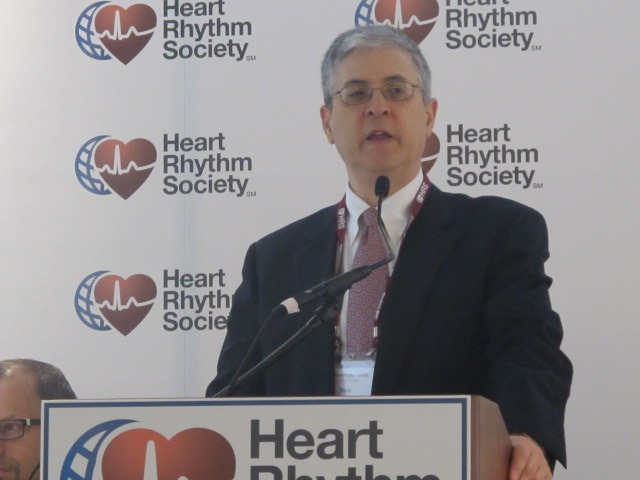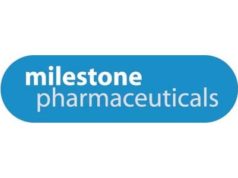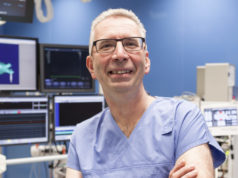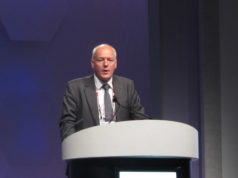
A phase 2 trial (NODE-1) of a nasal spray formulation of etripamil (Milestone Pharmaceuticals) shows it is safe and effective at terminating paroxysmal supraventricular tachycardia (PSVT) and has the potential to be a “game-changer” in the treatment of the condition. The data were presented at a late-breaking clinical trial session at the Heart Rhythm Society’s 38th Annual Scientific Sessions (10–13 May, Chicago, USA), and were hailed as “significant” and “intriguing”.
Investigator Bruce S Stambler, from the Piedmont Heart Institute, in Atlanta, USA, told delegates: “These phase 2 data support the further development of intranasal etripamil in a real-world setting of patient self-administration to terminate PSVT outside the hospital. If successful, etripamil could provide a fast acting nasal spray that can safely terminate acute PSVT without the need for an urgent care visit, and could change the treatment paradigm for acute management of PSVT.”
He added: “[This] is a game-changer, because it provides another option for patients to choose, other than ablation. There are patients concerned about the anxiety of having an episode at an unpredictable time. It has the opportunity to change how we treat this common rhythm disturbance, and it is very exciting because this intranasal form of therapy is not something we have seen before as electrophysiologists. It may provide opportunities for other drug delivery in the future. That makes it unique and interesting.”
Jeanne E Poole (University of Washington, Seattle, USA), co-chair at the late-breaking clinical trial session, agreed: “I think these are very interesting and intriguing results, and I am excited. I think it could be a game-changer. Obviously there will be further studies, larger studies, performed in order to confirm these results. This could be actually very useful for patients.”

Andrew D Krahn (University of British Columbia, Vancouver, Canada), co-chair at the late-breaking session, said: “It potentially has an impact, and it could be significant. We have to get more data, but it will potentially have a very strong impact on the way in which things are done.”

PSVT is regular tachycardia of abrupt onset and termination. PSVT termination may require acute IV administration of adenosine, calcium channel blockers, or beta-blockers to restore sinus rhythm. Etripamil is a rapid-onset, short-acting L type calcium channel blocker with rapid metabolism designed for intranasal administration. It is highly potent, with a very short half-life of less than five minutes. It is being developed as a self-administered therapy to terminate PSVT outside of the emergency room or hospital.
Stambler explained: “Adenosine, intravenous IV calcium channel blockers, or beta-blockers can only be administered through an IV access in an acute care facility. There are no agents currently available that can be administered by a patient outside of the hospital setting, in the home environment, for example. A non-parenteral agent that patients can use to acutely terminate PSVT outside of the hospital environment would be beneficial. The study was designed to demonstrate superiority of at least one dose of intranasal etripamil over placebo in terminating PSVT, induced in an electrophysiology laboratory. Secondary objectives were to establish a dose-related trend to determine the minimal effective dose, and to evaluate the safety of etripamil. Finally, the study sought to determine an optimal dose, based on the balance between efficacy and safety, to proceed with in future phase 3 trials outside of the hospital environment.”
NODE-1 was a multicentre randomised parallel group double-blind placebo controlled electrophysiological study in which 199 patients were enrolled at 35 sites in the USA and Canada. Of these, 95 were withdrawn for a variety of other reasons. Once PSVT had been sustained for five minutes or more, the remaining 104 patients were randomised to receive either placebo (n=20), 35mg etripamil (n=20), 70mg (n=23), 105mg (n=20), or 140mg etripamil (n=21). There were no significant differences in baseline characteristics between study groups.
Eligible patients were males and females ≥18 years, with history of PSVT, and scheduled to undergo electrophysiology study, and possible catheter ablation. Median age was 55 years, and 57% of patients were female. The primary endpoint was the termination rate of PSVT within 15 minutes of study drug administration. Secondary endpoints included time to conversion, dose-related trends in efficacy, and side-effects.
Conversion rates were 65% for 35mg etripamil, 87% for 70mg, 75% for 105mg, and 95% for 140mg, compared to 35% in the placebo group.
Stambler said: “Etripamil 70mg, 105mg, and 140mg doses demonstrated high efficacy, significantly better than placebo, for acute termination of PSVT induced in an EP lab. The median conversion time was 2‒3 minutes. Etripamil had an acceptable safety profile and was well tolerated. The three highest doses—70mg, 105mg, and 140mg of etripamil—were all statistically significantly different from placebo conversion rates. The 35mg conversion rate at 65%, although higher than placebo, did not reach statistical significance, likely related to the small sample size of the study. Conversions occurred faster and at higher rates and higher doses of etripamil.”
The most common adverse events were related to the intranasal route of administration of the drug, and occurred more commonly in etripamil patients than placebo patients. A transient reduction in blood pressure was observed at the two highest doses, and one case of hypotension was reported as an adverse event.
Stambler said: “In this study we proved the concept that intranasal etripamil is a safe and effective option, and we also defined what is going to be the optimal dose going forward in the future outside the hospital environment. It appeared that the sweet spot was the 70mg dose. The safety concerns occurred with blood pressure at the higher doses—the 105mg and 140mg. The 70mg dose was associated with an 87% conversion rate within 2‒3 minutes, it did not have any significant effects on lowering blood pressure, and it seemed to be an optimal dose, but that will need to be proven. The phase 3 study has not been finalised, but tentatively it would probably be a study outside the hospital environment. That is the next step. Patients in the phase 3 trial will likely need some sort of event monitor so that we can further understand this compound outside of the hospital environment. This is a very unique opportunity.”

Thomas F Deering, HRS 2017 Scientific Sessions Programme chair and moderator at a press conference on the HRS late-breaking clinical trials, said: “We clearly need more data, this is a feasibility trial. We now need to carry it to the next level from the electrophysiology lab into the clinical arena, whether that be the emergency room or the outpatients setting. One of the things that is going to be very important is patient selection. We have got to be very careful, if it ever reaches FDA approval, that it is appropriately defined for the right person and the right reason.”
Stambler concluded: “In the USA, it is estimated that there are 90,000 new patients every year diagnosed with PSVT, and there are 50,000 emergency visits, so that means if you calculate it, 20 patients every hour are having episodes, just in the USA alone. It is pretty common. Giving them this option, if it is continued to be proved safe and effective, provides a choice for people and gives them the ability to have some confidence that if they do have an episode they have a mechanism and means, potentially, to get themselves out of trouble. This is a potential new therapy that patients could use at home on an as-needed basis, or anywhere in their environment—they could carry it with them. Our data show that this treatment is highly effective and safe.”









